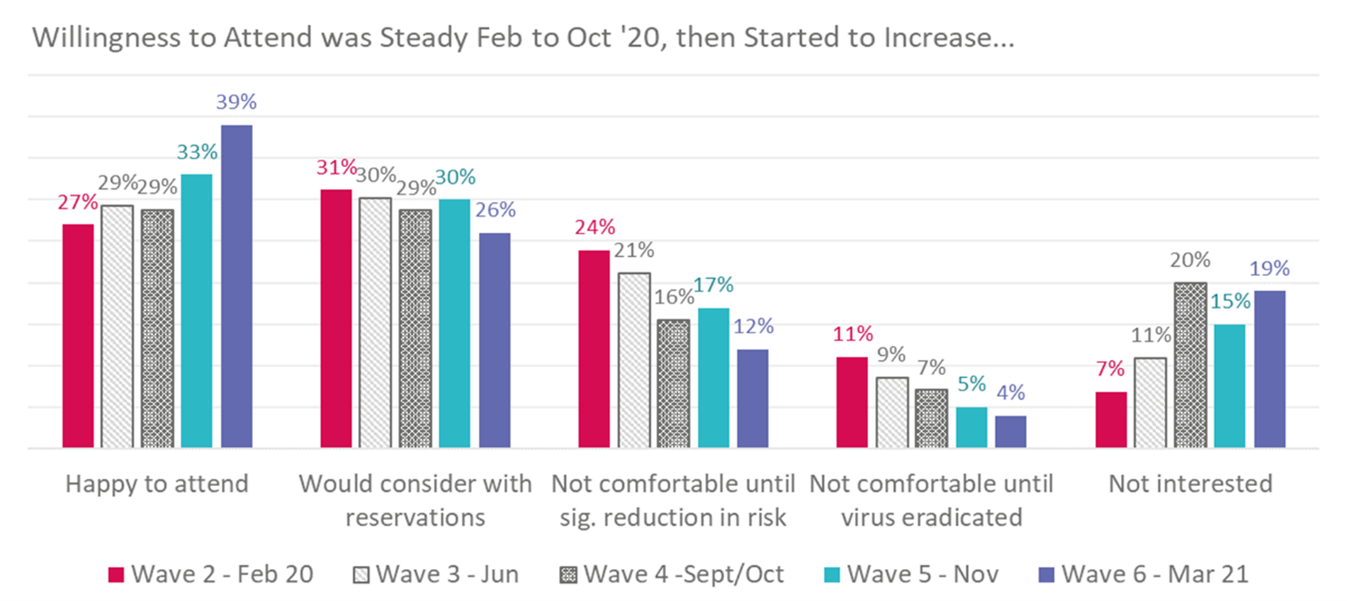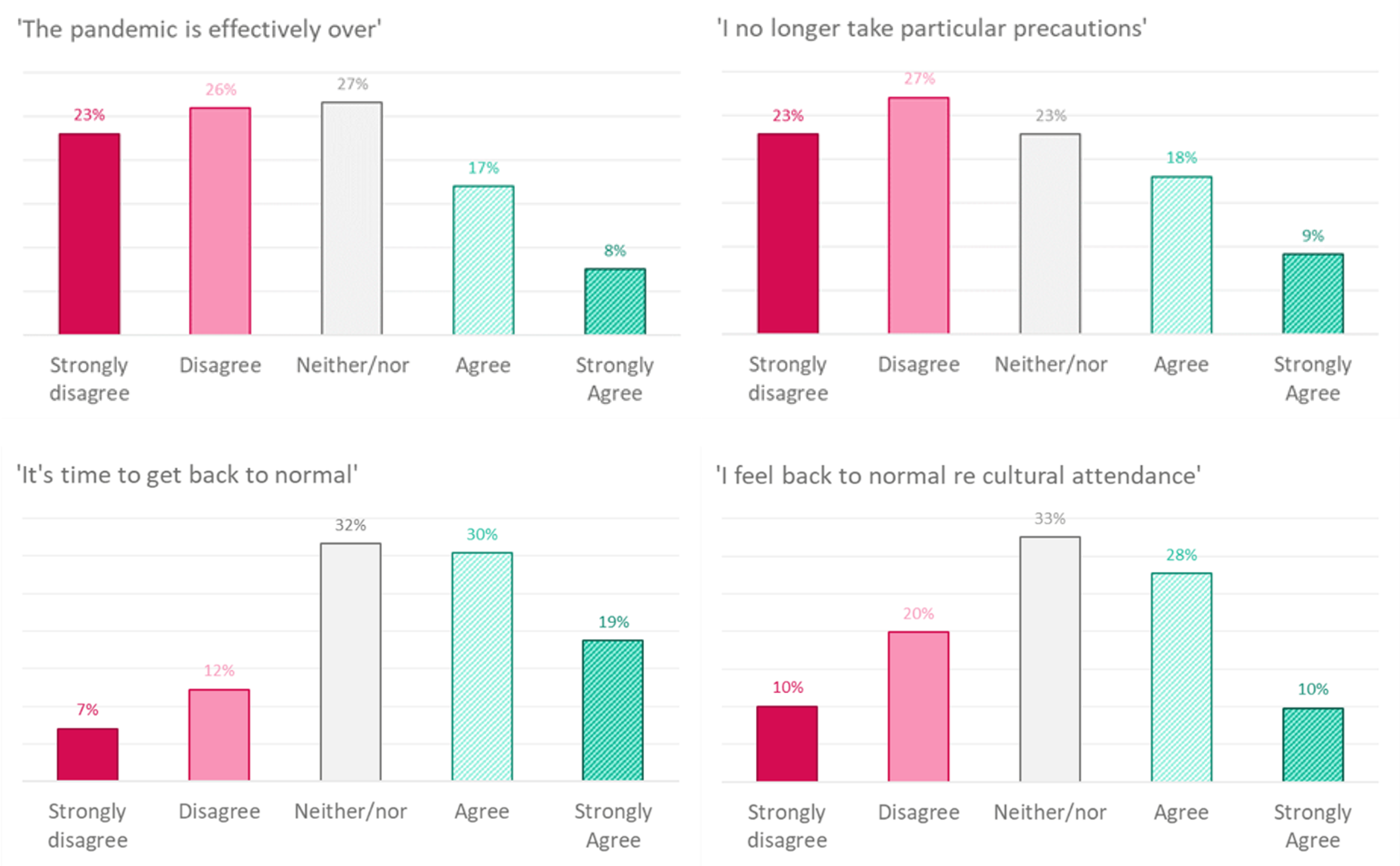Willingness to attend events, especially outdoors, is rising
April 2022
This research is from The Audience Agency's nationwide longitudinal (ongoing) panel survey of changing views about participating in creative and cultural activities through the recent and ongoing crises, and beyond, the Cultural Participation Monitor.
Contents
- Overall willingness to attend
- Perceived risk from attending indoor events
- Wider attitudes to COVID-19
- The groups more/less likely to attend
Themes
Overall there is much increased willingness to attend events and optimism about future attendance, though some groups continue to be especially concerned, with disabled people less likely to be willing or able to attend.
Overall willingness to attend
Willingness to attend overall is up to 39% saying they are ‘happy to attend’ (from 30% in November 2021), whereas 20% of people cite Covid-19 as a reason they don’t want to attend.
- People are split on whether the end of Covid-19 rules makes them more or less confident, with around a third for each and the remainder saying neither.
- They are also split on whether their in-person arts attendance will be the same or less than before the pandemic, with about 40% for both. This is itself an increase from November, when more expected to do less than to do more.

Perceived risk from attending indoor events
People still feel far less at risk of contracting the virus at outdoor events.
- 39% of people think the risk of catching or spreading Covid-19 indoors averaged across all cultural events is high/very high, but this reduces to 13% when events are outdoors.
- In comparison, 20% assume the same risk when doing day-to-day activities.
Wider attitudes to COVID-19
Attitudes to Covid-19 are still very divided, with the public holding a broad range of viewpoints.
- Overall, more people say that they think that Covid-19 is not over and that they still take precautions than say the opposite.
- On the other hand, more also say that it is time to get back to normal and that their own attendance is back to normal.

At an individual level though, people are generally more consistent with assessing risk, or being willing to attend events relative to their attitudes to Covid-19, than this overall picture may suggest. Meaning that the same people who think the threat is low and that we should be getting back to normal, are happy to return to indoor events and plan to spend the same amount on entertainment.
- Those completely happy to attend are much less likely to assess a high risk of Covid-19 indoors, and 3 times more of them think we should accept Covid-19 and live normally compared to the overall population.
- For those who think there’s a low risk, they are less than half as likely as people generally to say their spending on entertainment will decrease a little/a lot.
The groups more/less likely to attend
Older people and those with disabilities or long term health conditions remain the most cautious about 'getting back to normal', while under-25 year-olds are leading the return charge.
- Those who identify as disabled/(D/d)eaf/having a long-term health condition(from now on ‘disabled’) are less likely to say they are back to normal in attending events and are even more likely to say they’ll attend events more locally.
- Normal attendance levels are driven by the 16-24 age group, where over half agree they are back to normal.
- Back to normal attitudes and attendance are also much higher in Asian/Asian British people.
- As expected, the over-65s are more likely to say they won’t attend cultural events as often in the future.
Related videos
Cultural Participation Monitor | Latest Findings on Audience Attitude and Behaviours
Watch nowTEA Break: Bad behaviour? - What types of behaviour people prefer when attending culture
Watch nowTEA Break | From Interest into Action
Watch nowTEA Break | More Insights on Changing Audiences
Watch nowTEA Break | Key Changing Audiences for Art Forms
Watch nowOther findings from Wave 6 | Apr 2022 | Shifts, outdoors, working from home, cost of living
-
Nearly half of people engaged with arts and culture digitally during the pandemic
Nearly half of people say that they engaged with arts and culture online in some form during the pandemic, weighted towards audiences who are younger, typically high cultural engagers anyway, or disabled.
-
Support for Covid-19 safety measures is starting to ebb
Safety measures are rated as less important than they have been previously, but desire for them continues, with half of audiences still saying that they would not attend if precautions were removed all together.
-
The cost of living crisis is starting to impact people's willingness or ability to spend on arts and culture
The cost of living crisis is emerging as a predictable barrier to engagement, and is particularly likely to affect frequency of attendance (more than spend per attendance - though increased prices would act as a further deterrent).
